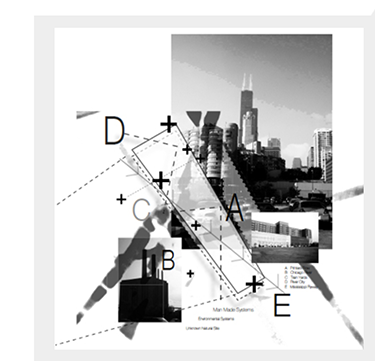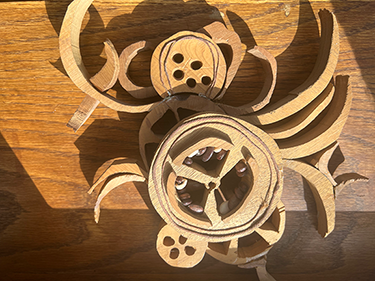
Have you been collecting things lately? Do you want to take a range of visual elements and combine them in a creative way to communicate a message or tell a story? You are probably going to make a collage! Collage is a visual art technique that involves sticking pieces of paper, photographs, fabric, newsprint, charts, and even three-dimensional objects to a work of art. Collage layers visual issues and concepts. From the French term “papiers collés” (or découpage), collages involve pasting paper cutouts onto various surfaces. Making collages enhances creativity while introducing design elements like color, pattern, composition, shapes, forms, and communication. Activities include gluing, sticking, taping, stapling, cutting, tearing, and layering of diverse materials and found objects. Collaging extends focus and concentration and can open personal awareness and emotional growth. It communicates emotions. Photomontage, decoupage, fabric collage, and digital collages are all different approaches to combining media.
Let’s get collaging!
Activity 1 – Collages Communicate

Collage Art successfully challenges traditional definitions of creating art. High and low-culture materials and objects may combine in the same work. High culture is usually understood as works of art that are held in high esteem by the art world over decades and even throughout centuries of history. On the other hand, low culture represents the ever-changing popular culture or the social buzz of the moment. Whether purposeful or spontaneous, the comparison created by contrasting different elements captivates our attention. Collages take on new meanings within different contexts. Collages overturn traditional meanings associated with art (and life) and imply multiple purposes simultaneously. The many types of collage open up the artistic potential for new ways of communicating ideas. Think of something that you want to communicate or say. Keep it in mind as you look for objects, materials, and photos that could be combined to open charge discussion!
Upload your collage to the gallery!
Activity 2 – Painted Paper Collages
Painted paper collages use hand-painted paper clippings. Once dried, tear or cut the paper into any shape or size you wish and glue it to a surface. If you want to create something specific, sketch it out, and paste the color pieces inside. Painted Collages create an abstract pattern with rich palettes of colors.
Another type of Collage, “The French Découper,” means “cut out. It involves arranging and pasting colored paper cutouts onto paper, linoleum, plastic, or other flat materials, gluing them to a surface, and covering them with lacquer or varnish. Henri Matisse created many notable découpage artworks, such as Blue Nude II (1952). He also made many painted paper collages.
Using photos, and cut paper, make a painted paper collage!
Activity 3 – Photomontage Collages

Photo montages are the most common type of Collage. Collages use found images. Explore a site in your city and take snapshots of all the aspects of its architecture and design that inspire you. Look for people, places, and things. Look down at the ground, look at the textures and edges and details. Look up at the sky. Create a photomontage collage based on your own snapshots from your site visit. Images reveal the beauty of color, texture, pattern, people, places, and seasons. There is no limit to what photo collages can communicate.
Upload your photo montage to the gallery.
Activity 4 – Found Objects Collage

Put on your adventure hats and take this week to explore memorable places and materials. Maybe you collect seashells and sand from your walks at the beach. Perhaps you have your grandma’s old kitchen utensils, beaded jewelry, or pins. You may be interested in rocks and have a collection of them. Just look around your house, and you will find beads, coins, buttons, and other people-made objects to collect. Or step outside and discover the wonder of nature, like sticks, leaves, grasses, and flowers. The possibilities are endless. Using various collectible materials and objects, visualize a theme you want to communicate with your audience and create a found objects three-dimensional Collage. Then, please take a photo and share it in the gallery!
Activity 5 – Fabric Collages
Fabric Collages use soft material cut, sewn, or glued into different forms onto a background. Start by collecting scraps of cloth of different colors, textures, and sizes. Felt, velvet, cotton, denim, wool, anything is possible. Next, consider yarn, embroidery thread, and even string and rope. Then, imagine what you would like to create. Is it a portrait? Is it a garden or a landscape? Next, glue the fabric flat or fill it with stuffing to become three-dimensional.
Make a fabric collage! Upload it to the gallery!
Activity 6 – Make a Digital Collage

Modern technology has led to the rise of digital collage art or eCollage created on the computer and utilizing photo-editing software programs.
From the Adobe Suite of Photoshop and Illustrator, one can digitally assimilate collages and layered images and content. For example, look at the work of Architect James Corner, Taking Measure Across the American Landscape or Tatiana Bilboa, to see how photographs, drawings, and diagrams can combine to express information poetically. eCOllages as gifs introduce the art of animated cells or image by image building on the images that came before. Digital eCollages started from Info Graphics and Information Architecture expressing emotions, but also data and facts about the world around us. Today eCollages generate new ways of seeing, thinking observing, and discovering!
Try your hand and mouse at a digital Collage!
Share it on the gallery!
Review
- Fabric collages must always be flat; stuffing is not used.
- In découpage, you arrange and paste colored paper cutouts onto a surface.
- Photomontage collages are built only from drawings, not photographs.
- Found-object collages can include items like buttons, shells, and sticks.
Explore
- 110 Decoupage Ideas Pinterest
- Art Movements Collage
- Art Movements Timeline
- Collage as Practice Tatiana Bilbao
- DADA Collage TATE
- Fabric Collages
- Found Object Collages
- James Cornell Box Collages
- James Corner Collages
- James Corner Taking Measure Across the American Landscape
- Jesse Hedden Wood Collages
- Leni Weiner Fabric Collagist
- Louise Nevelson Collages & Assemblages
- Matisse Paper Collages
- Matisse Paper Cut Outs
- PAVEL ZOUBEK Collage Artist
- Picasso & Paper
- Picasso's love of Scraps
- San Fran Collage Artists International Exhibit
- Simple tips to make a collage
- Tate Kids Make a Matisse Collage
- The Accidental Surrealist: Toshiko Okanoue
- Toshiko Okanoue Photo Collages
- Vienna" Collage Artworks
- Vik Muniz Surfaces
Relate
- 2D Geometry
- 3D Geometry
- Angles
- Collage
- Color
- Composition
- Conceptual Sketching
- Diagramming
- Drawing Types
- Experience Design
- Figure Ground
- Font
- Form
- Graphs + Charts
- Imagination
- Information Architecture
- Lines
- Maps
- Material Matters
- Mind Mapping
- Murals
- Objects
- Painting
- Paper
- Pattern
- People
- Photography
- Poster Design
- Questions
- Shape
- Signs
- Sketching
- Story Telling
- Time
- Words


















































